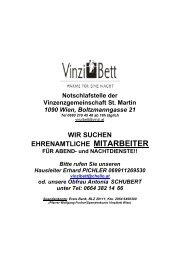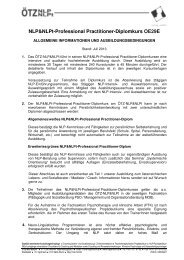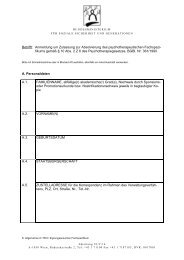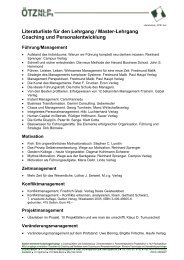AUSGANGSLAGE
AUSGANGSLAGE
AUSGANGSLAGE
Erfolgreiche ePaper selbst erstellen
Machen Sie aus Ihren PDF Publikationen ein blätterbares Flipbook mit unserer einzigartigen Google optimierten e-Paper Software.
ANSUCH9d1.DOC<br />
TI: Belief change and neurolinguistic programming.<br />
AU: Davis,-Donald-I.; Davis,-Susan-L.<br />
IN: Family Therapy Inst of Alexandria, VA, US<br />
JN: Family-Dynamics-of-Addiction-Quarterly; 1991 Jun Vol 1(2) 34-44<br />
AB: Discusses limiting beliefs and ways to change them in therapy. The basic elements of a<br />
belief change process included at least some of the following: eliciting and installing appropriate,<br />
resourceful states in the client; a procedure for going back in memory with these new resources; an<br />
objective assessment of the new generalizations formed; consolidation and integration of the new<br />
beliefs; mental rehearsal of the future; and testing the new beliefs. A case illustration involving a<br />
woman in her 30s is presented.<br />
TI: Neuro-Linguistic Programming and family therapy.<br />
AU: Davis,-Susan-L.; Davis,-Donald-I.<br />
IN: Family Therapy Inst of Alexandria, VA<br />
JN: Journal-of-Marital-and-Family-Therapy; 1983 Jul Vol 9(3) 283-291<br />
AB: Presents 2 types of intervention for facilitating communication in family therapy that are<br />
based on the neurolinguistic programming (NLP) technique developed by R. Bandler and J. Grinder<br />
(1975) and Grinder and Bandler (1976). These interventions deal with identifying and bridging<br />
sensory differences between family members and with anchoring responses to contexts in which<br />
they would be desirable. Two clinical examples illustrate how NLP can be used to identify<br />
behavioral sequences, use this information to evoke the desired response in the patient, and<br />
bypass conscious resistance.<br />
TI: Neurolinguistic programming in orientation and mobility<br />
AU: Williams-MF; Jacobson-WH<br />
AD: Department of Rehabilitation, University of Arkansas,<br />
2801 South University Avenue, Little Rock, AR 72204, United States<br />
SO: J-VISUAL-IMPAIRM-BLINDN. 83/9 (454-456) 1989<br />
AB: Neurolinguistic programming is a communication model whose basic principles are that<br />
human beings process information through the five senses (representational systems), tend to favor<br />
one of the primary representational systems (visual, auditory, or kinesthetic) over others, and<br />
display how they are thinking in subtle ways. This article describes this model in detail and<br />
discusses how orientation and mobility instructors can implement it to teach congenitally totally blind<br />
students, who have access to only the auditory and kinesthetic primary systems, to use a cane or a<br />
dog guide more effectively.<br />
TI: Bitte sprechen Sie ... jetzt!<br />
Sprachtherapie mit NLP aus der Sicht eines angehenden NLP-Practitioners<br />
AU: D'-Hondt,-Sabine<br />
SO: MultiMind - NLP aktuell, 1994, 1, 24-26<br />
AB: Anhand von zwei Fallbeispielen wird gezeigt, wie die Techniken des Neurolinguistischen<br />
Programmierens in der stationaeren neurologischen Sprachtherapie von Erwachsenen eingesetzt<br />
werden koennen. Dabei wird insbesondere auf das Wechselspiel von „Pacing“ und „Leading“ zur<br />
Herstellung von Rapport in Gespraechssituationen mit den Patienten sowie auf die Prinzipien des<br />
„Well formed outcome“ eingegangen.<br />
TI: The NLP swish pattern: An innovative visualizing technique.<br />
AU: Masters,-Betsy-J.; Rawlins,-Melanie-E.; Rawlins,-Larry-D.; Weidner,-Jean<br />
IN: Cowden-Herrick Schools, Cowden, IL, US<br />
JN: Journal-of-Mental-Health-Counseling; 1991 Jan Vol 13(1) 79-90<br />
AB: Describes the swish pattern visualizing technique developed within the neurolinguistic<br />
programming (NLP) framework. A brief overview of NLP is followed by an explanation of the basic<br />
theory and expected outcomes of the swish. Specific steps for using the swish include identifying<br />
the context, creating a desired self-image, checking ecology, swishing, and testing. Two case<br />
© Schütz, Schneider-Sommer, Gross, Jelem 1999<br />
Theorie und Praxis Neuro-Linguistischer Psychotherapie Seite 128/143






